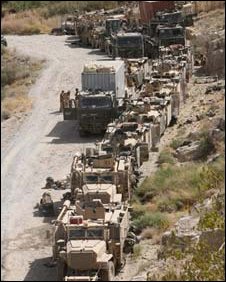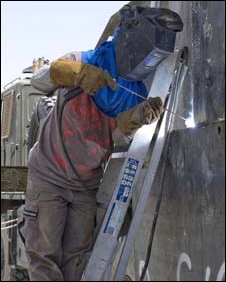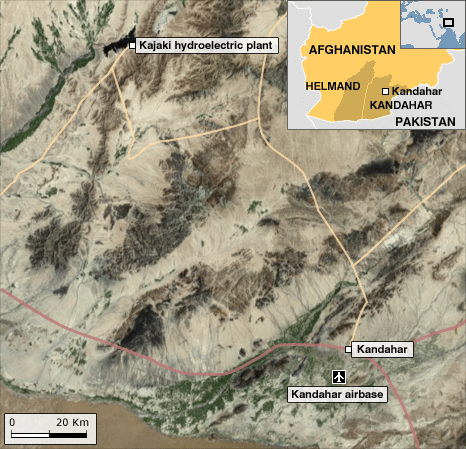UK troops
in huge turbine mission
Sep 2, 2008 - Alastair Leithead -
BBC News
Almost three thousand British troops in southern Afghanistan
have successfully transported a huge hydroelectric power
turbine through Taleban territory.
In one of their biggest operations in Helmand, a convoy
of 100 vehicles took five days to move the massive sections
of the turbine 180km (112 miles).
The $6m (£3.4m) turbine will produce electricity for
an extra 1.9m people.
Prime Minister Gordon Brown said the operation was
a reminder of Nato's "fundamental purpose" in Afghanistan.
The operation to increase the output of the Kajaki dam
in southern Afghanistan is part of a development project
which has been planned for two years.
Late at night
The convoy travelled the length of the Helmand river
valley - through areas insurgents have controlled for
more than two years - carrying seven 20-30 tonne sections.
A spokesman said it was the largest route clearance
operation the British military has carried out since
World War II.
Mr Brown said: "It is yet another example of the skill
and courage of our forces, but also a reminder of the
fundamental purpose of why they are there - the long
term development of Afghanistan, giving the people a
stake in the future." Around 1,000 other Nato troops
from the US, Australia, Denmark and Canada were involved
and 1,000 Afghan soldiers protected the turbine through
one of the most dangerous parts of the journey.
Canadian forces took the convoy on the first leg late
at night on Wednesday 27 August. For key points on route
(Refers to map at bottom)
| The sections were surrounded by layers of steel
to make them look like ordinary containers |
They moved out from Kandahar airbase along the main
highway and up the Helmand valley to a meeting point
in the desert where British forces took over responsibility.
It was slow going from there, where the road is little
more than a dirt track.
Hundreds of British and American special forces troops
went in first, sweeping through the green zone of trees,
fields, deep irrigation ditches and high-walled compounds
where the Taleban are concentrated.
Although it is impossible to verify, British commanders
estimated they killed more than 200 insurgents - without
any losses or injuries to Nato soldiers - in heavy fighting
which included artillery fire and air strikes.
Unmanned drones
Lt Col James Learmont from 7 Para Royal Horse Artillery
said they then tricked the Taleban into thinking the
convoy was heading straight up the valley, but actually
went through the desert on a track used by local people.
 |
| British troop convoy transporting
turbine Planning for the massive operation began
two years ago |
Fifty Viking armoured vehicles drove alongside the
main convoy which stretched 4km. It included fuel trucks
and the eight heavy equipment transporters carrying
a crane and the Chinese-made turbine.
The sections were surrounded by layers of steel to
make them look like ordinary containers and to offer
some defence against small arms fire, or rocket propelled
grenades.
Protection from the air was provided round the clock
by British Harrier jump jets and Apache helicopters,
as well as French, Dutch and American aircraft. Unmanned
drones watched the area ahead of the convoy for any
impending insurgent attack.
Infantry troops from all three battalions of the Parachute
Regiment covered both sides of the route - leapfrogging
ahead of each other in 13 Chinook British and ISAF helicopters,
as the slow-moving load edged towards the Kajaki lake
at the head of the valley.
Royal Engineers stayed out in front, clearing improvised
bombs and strengthening the road as they went along.
There was a serious risk of direct attack or roadside
bombs, so Pathfinder reconnaissance troops were sent
ahead weeks before and discovered the alternative route.
Although much rougher and slower it was considered
a lot safer.
They took, and held, high ground to protect the vehicles
and called in airstrikes in the full knowledge of how
damaging any civilian casualties would be to the support
of their presence in Helmand.
There were many breakdowns along the way with tyres
blowing out and air brake pipes being damaged on the
bumpy road.
The Royal Regiment of Electrical and Mechanical Engineers
did the rolling repairs and kept the convoy moving as
quickly as possible, which at times was only 4km per
hour.
Oqab Tsuka
Planning to get the turbine into the Kajaki hydroelectric
plant started in 2006 - 30 years after it was originally
built by USAID, which has paid for the turbine and is
responsible for the development project. Soldier welding
steel onto turbine section The parts were covered in
steel to protect and disguise them.
 |
| The parts were covered in steel
to protect and disguise them |
|
For the past four months, 60 British officers have
been planning for every eventuality and war-gaming what
might happen on the ground.
They were surprised how well the mission had gone -
there had been criticism of the plan from military and
non-military quarters, saying it should wait until next
spring because the Taleban had been so active.
The power station only ever had two turbines with power
lines heading off down to the provincial capital Lashkar
Gah, but a space was left between turbines one and three
for this latest addition.
Indeed, the operation was codenamed Oqab Tsuka, but
known as "T2" among the troops.
When turbine two eventually comes online, and when
a new grid of power lines are put up in the dangerous
valley, it will be able to provide 51 megawatts of power.
But this could take two years or more depending on
the security situation and the fear is that people's
expectations are high now the turbine has been delivered
and they will be expecting electricity very soon.
At least getting the turbine in and achieving one of
the main aims of the last three years is a sign of progress
in the Helmand valley where most of Britain's 8,000
troops are based.
 |
|
Map showing
Kandahar airbase and Kajaki hydroelectric plant
|
*7 sections of turbine, each weighing 20-30 tonnes
*100 vehicles in convoy, stretching for 4km
*50 Viking armoured vehicles alongside
*Round-the-clock air protection from British, US, French
and Dutch aircraft and unmanned drones
*3,000 British forces involved
*1,000 other Nato troops and 1,000 Afghan soldiers
helping protect convoy
*200 insurgents killed, according to British commanders